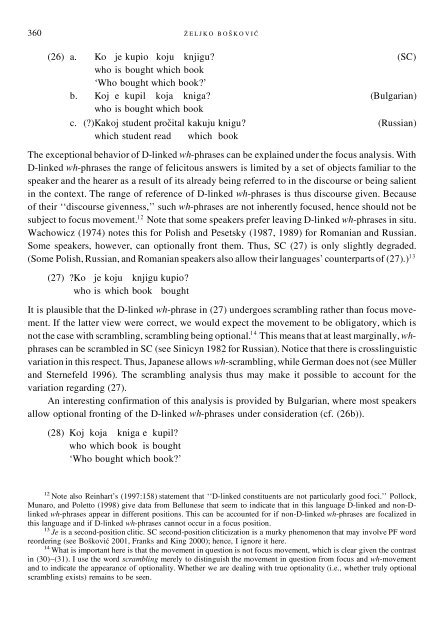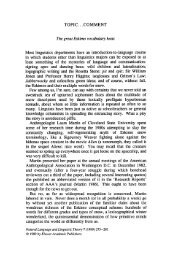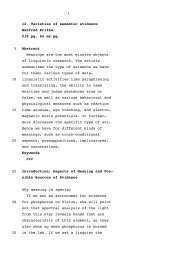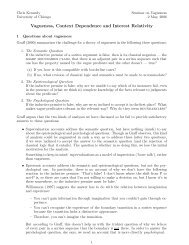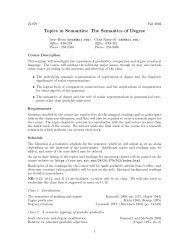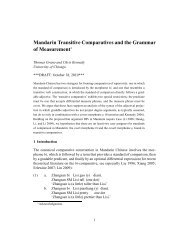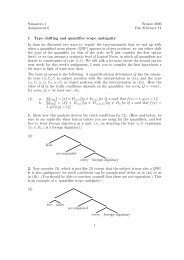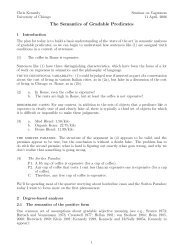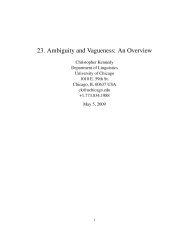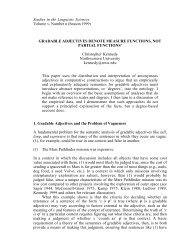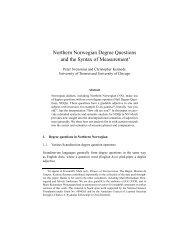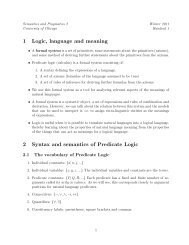On Multiple Wh-Fronting - University of Chicago
On Multiple Wh-Fronting - University of Chicago
On Multiple Wh-Fronting - University of Chicago
You also want an ePaper? Increase the reach of your titles
YUMPU automatically turns print PDFs into web optimized ePapers that Google loves.
360 ZÏ E L J K O B O SÏ K O V I Ć(26) a. Ko je kupio koju knjigu?(SC)who is bought which book‘<strong>Wh</strong>o bought which book?’b. Koj e kupil koja kniga?(Bulgarian)who is bought which bookc. (?)Kakoj student procÏ ital kakuju knigu?(Russian)which student read which bookThe exceptional behavior <strong>of</strong> D-linked wh-phrases can be explained under the focus analysis. WithD-linked wh-phrases the range <strong>of</strong> felicitous answers is limited by a set <strong>of</strong> objects familiar to thespeaker and the hearer as a result <strong>of</strong> its already being referred to in the discourse or being salientin the context. The range <strong>of</strong> reference <strong>of</strong> D-linked wh-phrases is thus discourse given. Because<strong>of</strong> their ‘‘discourse givenness,’’ such wh-phrases are not inherently focused, hence should not besubject to focus movement. 1 2 Note that some speakers prefer leaving D-linked wh-phrases in situ.Wachowicz (1974) notes this for Polish and Pesetsky (1987, 1989) for Romanian and Russian.Some speakers, however, can optionally front them. Thus, SC (27) is only slightly degraded.(Some Polish, Russian, and Romanian speakers also allow their languages’ counterparts <strong>of</strong> (27).) 1 3(27) ?Ko je koju knjigu kupio?who is which book boughtIt is plausible that the D-linked wh-phrase in (27) undergoes scrambling rather than focus movement.If the latter view were correct, we would expect the movement to be obligatory, which isnot the case with scrambling, scrambling being optional. 1 4 This means that at least marginally, whphrasescan be scrambled in SC (see Sinicyn 1982 for Russian). Notice that there is crosslinguisticvariation in this respect. Thus, Japanese allows wh-scrambling, while German does not (see Müllerand Sternefeld 1996). The scrambling analysis thus may make it possible to account for thevariation regarding (27).An interesting confirmation <strong>of</strong> this analysis is provided by Bulgarian, where most speakersallow optional fronting <strong>of</strong> the D-linked wh-phrases under consideration (cf. (26b)).(28) Koj koja kniga e kupil?who which book is bought‘<strong>Wh</strong>o bought which book?’12 Note also Reinhart’s (1997:158) statement that ‘‘D-linked constituents are not particularly good foci.’’ Pollock,Munaro, and Poletto (1998) give data from Bellunese that seem to indicate that in this language D-linked and non-Dlinkedwh-phrases appear in different positions. This can be accounted for if non-D-linked wh-phrases are focalized inthis language and if D-linked wh-phrases cannot occur in a focus position.13 Je is a second-position clitic. SC second-position cliticization is a murky phenomenon that may involve PF wordreordering (see BosÏ ković 2001, Franks and King 2000); hence, I ignore it here.14 <strong>Wh</strong>at is important here is that the movement in question is not focus movement, which is clear given the contrastin (30)–(31). I use the word scrambling merely to distinguish the movement in question from focus and wh-movementand to indicate the appearance <strong>of</strong> optionality. <strong>Wh</strong>ether we are dealing with true optionality (i.e., whether truly optionalscrambling exists) remains to be seen.


